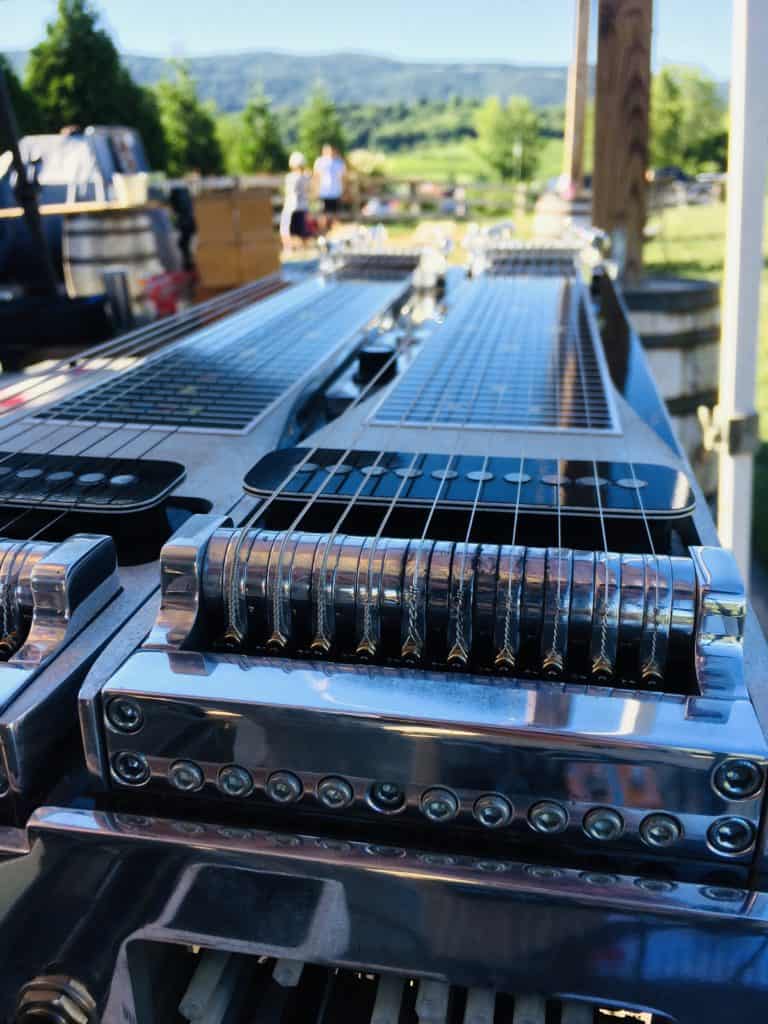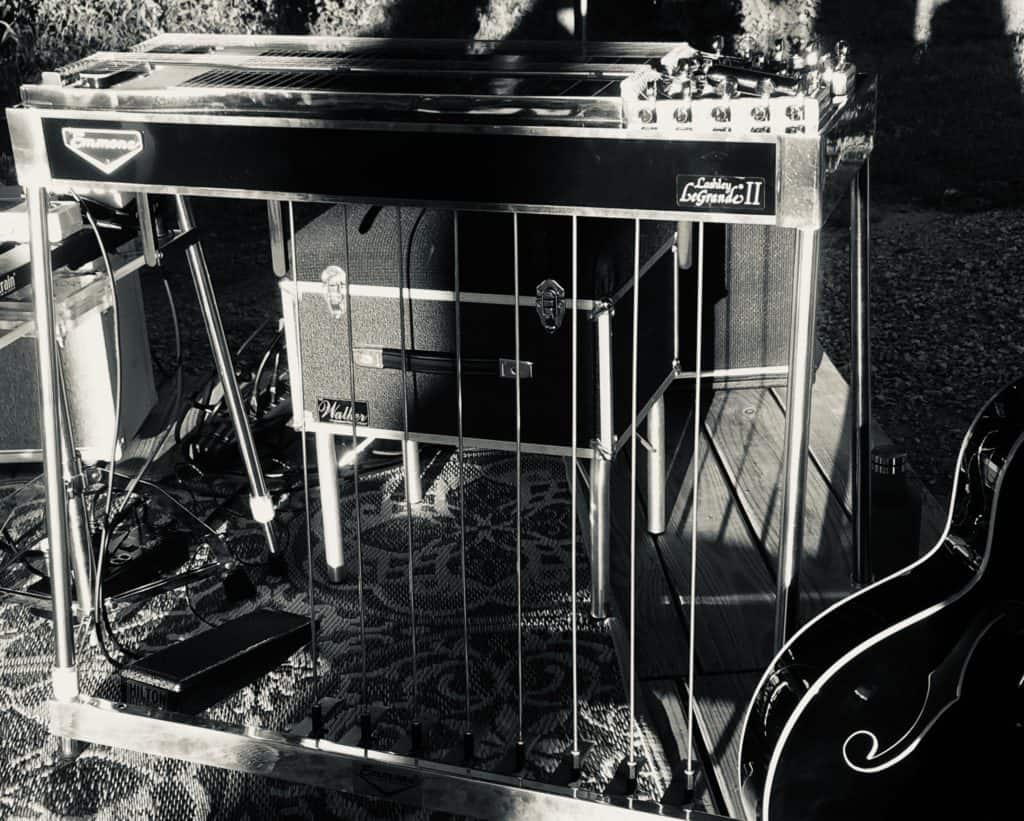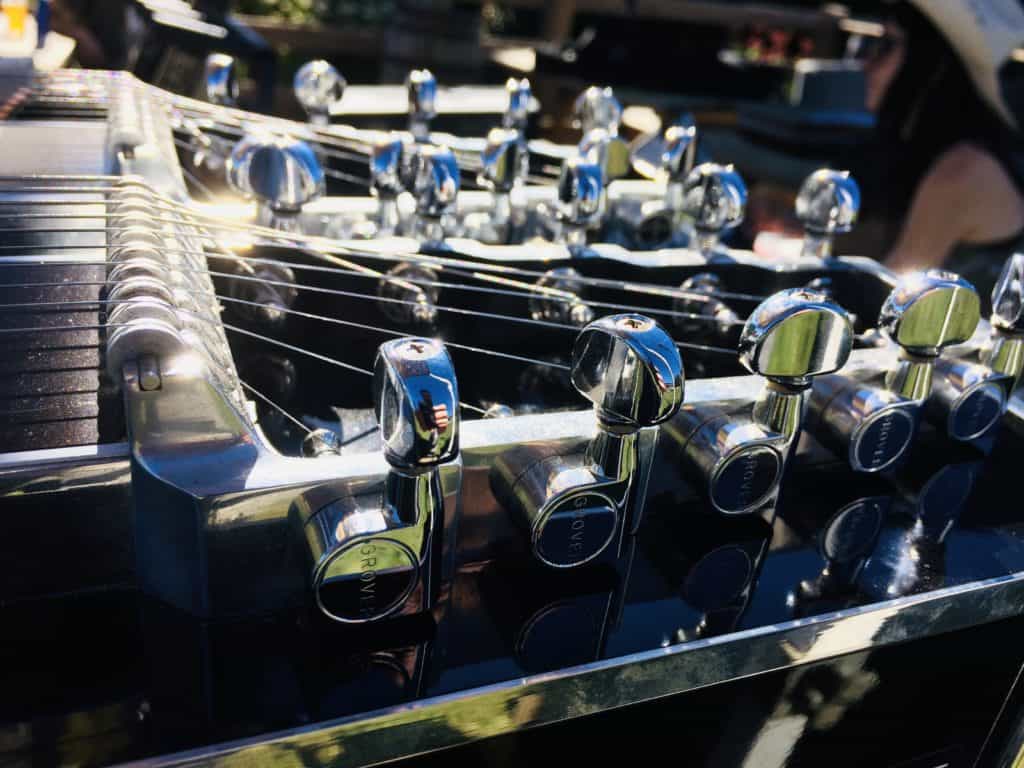As an Amazon Associate PlayPedalSteel.com earns from qualifying purchases.

When you see a double neck pedal steel guitar, you naturally wonder why the guitar has two necks. After all, it’s not very often that you come across instruments that have two of them built into one!
Pedal steels often have two necks because this allows a player to utilize two different tunings on the guitar. These pedal steels are often called double neck guitars, and most have the E9 and C6 tunings on them.
Many pedal steel builders and manufacturers build double neck guitars so that a player can play the E9 and C6 tunings, without having to switch instruments.
At first glance double neck pedal steels look complex and large in size, since they’ll often have 20 strings or more. However, they’re simpler than they look! Let’s take a closer look at them to understand why…
How Foot Pedals Contributed to Double Neck Pedal Steels
Before the creation of the pedal steel as we know it nowadays, many steel guitars were built with multiple necks so that players could switch tunings for different songs, or musical keys they were playing in.
Ever seen a quadruple neck steel guitar? These are great examples of these types of steel guitars, and they are quite amazing to look at! If you’re interested in reading more about how the steel guitar has evolved and its story, which is truly amazing, I highly recommend checking out The Hawaiian Steel Guitar and Its Great Hawaiian Musicians (click to view on Amazon).

Before pedal steel, a player would often find that various tunings on multiple necks were best suited for particular songs, especially if they were going to be utilizing open strings when they played.
When pedal steel started gaining popularity, using the pedals to change the pitches of strings allowed a player to essentially change tunings within each neck, which reduced the need for so many necks and different tunings.
Double Necks with the E9 and C6 Tunings
Nowadays, the differences between the C6 and E9 tunings are still significant enough that you may find the need to have both on your guitar. This is why the double neck pedal steel is very common to find, and why they’re still being built.
Although single neck pedal steels are often played as well, if you decide to learn both necks or tunings, you may have more playing options for voicing chords, certain intervals, as well as more pedal functions.
Double neck pedal steels usually have the C6 neck positioned closest to the player’s body, and the E9 neck is the neck furthest from the player.
Playing A Double Neck
When deciding whether to purchase a pedal steel with one or two necks, it is a good idea to take into account the difference between the two tunings.
If you want to learn and play the C6 neck, which is a great tuning for jazz and Western swing, then often your best choice is to get a double neck guitar.

Most single necks that are built only contain the E9 tuning on it, so it is much less common to come across a single neck that has the C6 tuning.
The E9 tuning, which seems to be more popular than the C6 neck nowadays, is great for certain kinds of country music where the pedal steel uses a lot of pedal movement to create certain sounds.
Pedal steel playing on the E9 neck is also gaining popularity in pop, Americana, and rock music, as well as many other styles. If you hear pedal steel on new recordings or songs nowadays, then there’s a good chance it is the E9 neck that you are hearing.
Learning the Two Necks
If you are new to pedal steel on either tuning, you may find that learning two necks at once is challenging. However, you can always start on one neck and then gradually begin incorporating the other into your playing.
Learning more about each of the tunings that are built into double neck pedal steels, is a great way to understand why you’d want both on your guitar. I wrote an article that displays the benefits and potentials of using the E9 tuning, which is often the neck most players start on nowadays.
Since both necks are essentially ten string guitars, look at how the two different necks can be expressed musically. This will help in understanding why both of them are often built into the instrument.
Buying a Double Neck Pedal Steel Guitar
When deciding to purchase a pedal steel with two necks, take into account that the guitar will probably be much heavier in weight if you are going to be transporting it to gigs or rehearsals. Often a double neck pedal steel will cost more than a single neck pedal steel of the same type or brand.
Having both necks can be a worthwhile investment however, particularly if you spend time playing and practicing each one. I’ve posted a complete pedal steel buyer’s guide that tells exactly what features to consider before buying double neck or single neck pedal steels.
Double neck pedal steels are a great way to play different types of music and styles on one instrument.
Watching a player that can play a double neck well can be very entertaining! It can certainly be a treat to hear them switch between the two necks, playing both in a tasteful manner.
Check out these pages for playing ideas and possibilities on each neck: